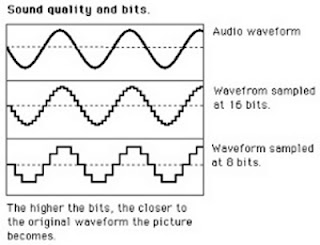DIGITAL SOUND
An audio recording can come in two basic types:
analog or digital. Both of these types are created by turning air pressure (the
sound) into electrical analog signal. In an analog recording the electrical
signals are directly imprinted onto the master tape or master record. These are
original copies of an audio tape that can be used to produce other copies. In
case of the analog recording, copies of the master tape or master record can be
made into cassette tapes or vinyls. In
the other hand digital recording makes a series of number out of the analog
signal, which the softerware of a computer will be able to understand. Once the
signal is digitalized, The recording can be copied ontp a compact disc, a hard
drive etc.
The fidelity of an analog recording depends on
the sensitivity of the equipment and the mediums used to record and play back
the audio.
The digital audio fidelity, however, depends on
the rate at which the recording equipment sampled the original sound wave over
a specific period of time. This last concept is known as sample rate and is
defined as the number of samples of a sound that are taken per second to
represent a sound wave digitally. Another measure of quality of digital adios
is the sample formant which is measured by the number of computer bits used to
represent each sample. The higher the number of bits used, the more accurate
and precise the representation of each sample will be. The number of bits is
also relevant because it, maximizes the difference between the loudest and the
softest possible sounds (dynamic range). Common sample formants are: 8-bit,
16-bit, 24-bit and 32-bit.
Some people claim that analog sound is better
than the digital one because it replicates the sound wave exactly as it was.
Nevertheless some people say that high sampling rates and increased precision have
erased any distinction that may have existed between these two types of sound.


